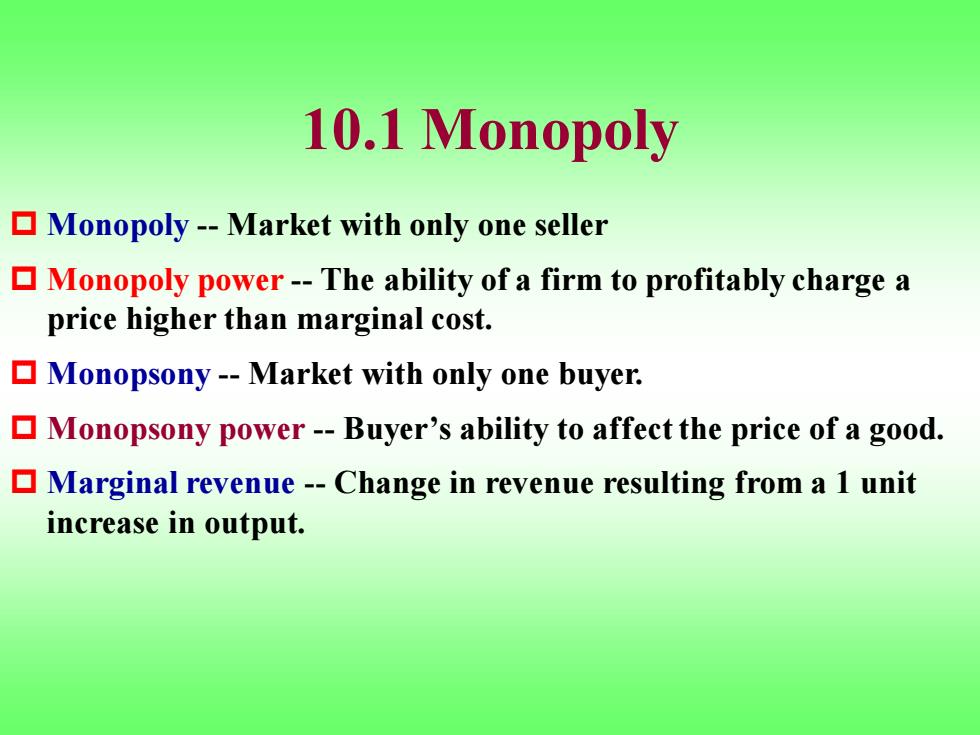
Chapter 10 Market Power: Monopoly and Monopsony Chapter Outline Monopoly Monopoly Power >Sources of Monopoly Power >The Social Costs of Monopoly Power Monopsony Power Limiting Market Power:The Antitrust Laws
Chapter 10 Market Power: Monopoly and Monopsony Chapter Outline ➢ Monopoly ➢ Monopoly Power ➢ Sources of Monopoly Power ➢ The Social Costs of Monopoly Power ➢ Monopsony Power ➢ Limiting Market Power: The Antitrust Laws

10.1 Monopoly Monopoly-Market with only one seller Monopoly power-The ability of a firm to profitably charge a price higher than marginal cost. Monopsony-Market with only one buyer. Monopsony power-Buyer's ability to affect the price of a good. Marginal revenue-Change in revenue resulting from a 1 unit increase in output
10.1 Monopoly Monopoly - Market with only one seller Monopoly power - The ability of a firm to profitably charge a price higher than marginal cost. Monopsony - Market with only one buyer. Monopsony power - Buyer’s ability to affect the price of a good. Marginal revenue - Change in revenue resulting from a 1 unit increase in output

Dollars per Unit of Output 6 4 Average Revenue(Demand) 3 2 Marginal Revenue 1 0 1 2 3 4 5 6 7 Output Average and Marginal Revenue Average and marginal revenue are shown for the demand curve P=6-Q R=PQ=Q(6-Q)=6Q-Q2,AR=6-Q MR=6-2Q
Average and Marginal Revenue Average and marginal revenue are shown for the demand curve P = 6 – Q R = PQ = Q(6 – Q) = 6Q – Q2 , AR = 6 - Q MR = 6 – 2Q

Price MC P1 P2 Lost profit from producing too little(Q1)and selling at D=AR too high a price(P1) Lost profit from producing too much(Q2)and selling at too low a price(P2) MR Q1 Q+ Q2 Quantity Profit is Maximized When Marginal Revenue Equals Marginal Cost
Profit is Maximized When Marginal Revenue Equals Marginal Cost

Q*is the output level at which MR=MC (n=R-C,profit-maximization △π/△Q=△R/△Q-△CI△Q=0). If the firm produces a smaller output-say,Q-it sacrifices some profit because the extra revenue that could be earned for producing and selling the units between Q and Q*exceeds cost of producing them. Similarly,expanding output from Q*to Q2 would reduce profit because the additional cost would exceed the additional revenue
Q* is the output level at which MR = MC ( =R -C, profit-maximization △/△Q = △R /△Q-△C/△Q= 0). If the firm produces a smaller output-say, Q1 -it sacrifices some profit because the extra revenue that could be earned for producing and selling the units between Q1 and Q* exceeds cost of producing them. Similarly, expanding output from Q* to Q2 would reduce profit because the additional cost would exceed the additional revenue

400 R 300 200 150 Profit 100 50 5 10 15 20 Example of Profit Maximization 8 40 MC 30 AC 20 AR 15 MR 10 15 20
Example of Profit Maximization

Part (a)shows total revenue R,total cost C,and profit,the difference between the two.Part(b)shows average and marginal revenue and average and marginal cost. Marginal revenue is the slope of the total revenue curve,and marginal cost is the slope of the total cost curve. Suppose:C(Q)=50+Q2(MC=△C/△Q=2Q) P(Q)=40-Q R=P(Q)Q=(40-Q)Q MR=40-2Q MC=MR 40-2Q=20 Q=10
Part (a) shows total revenue R, total cost C, and profit, the difference between the two. Part (b) shows average and marginal revenue and average and marginal cost. Marginal revenue is the slope of the total revenue curve, and marginal cost is the slope of the total cost curve. Suppose: C(Q) = 50 + Q2 (MC = △C/△Q = 2Q) P(Q) = 40 – Q R = P(Q)Q =( 40 – Q)Q MR = 40 – 2Q MC =MR 40 – 2Q = 2Q Q = 10

The profit-maximizing output is Q*=10,the point where marginal revenue equals marginal cost.At this output level, the slope of the profit curve is zero,and the slopes of the total revenue and total cost curves are equal. The profit per unit is $15,the difference between average revenue and average cost.Because 10 units are produced, total profit is $150
The profit-maximizing output is Q* = l0, the point where marginal revenue equals marginal cost. At this output level, the slope of the profit curve is zero, and the slopes of the total revenue and total cost curves are equal. The profit per unit is $15, the difference between average revenue and average cost. Because 10 units are produced, total profit is $150

A Rule of Thumb for Pricing(定价的简单(经验)法则) MR=△R/△Q=△(PQ)/△Q=P+Q(△P/△Q) =P+P(QP)(△P/△Q)=P+P(△P/P)/△Q/Q) =P+P(1/E) Because the firm's objective is to maximize profit,we can set marginal revenue equal to marginal cost: MR=P+P(1/E)=MC Which can be rearranged to give us P-MC)/P=-(1/Ea)
MR = △R/△Q = △(PQ)/△Q = P + Q (△P/△Q ) = P + P(Q/P) (△P/△Q ) = P + P (△P/P)/(△Q/Q ) = P + P (1/Ed ) Because the firm’s objective is to maximize profit, we can set marginal revenue equal to marginal cost: MR = P + P (1/Ed ) = MC Which can be rearranged to give us (P – MC)/P = - (1/Ed ) A Rule of Thumb for Pricing (定价的简单(经验)法则)

Equivalently,we can rearrange this equation to express price directly as a markup(标高的价格)over marginal cost: P=MC/1+(1/E)
Equivalently, we can rearrange this equation to express price directly as a markup (标高的价格) over marginal cost: P = MC/(1+(1/Ed ))